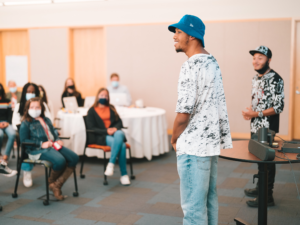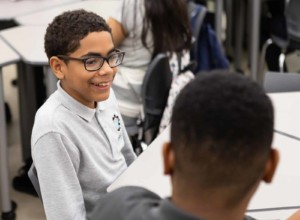Voices from the Field: Best Practices

By: Erin Gohl and Kristen Thorson
Schools are the foundation of our society. Our collective success depends on their success. They are responsible for building an educated and skilled workforce, ensuring an engaged citizenry, and developing critical thinkers who will solve unknown future global challenges. Community leaders and politicians are constantly trying to figure out the components that will make schools successful. All too often, these conversations, debates, and reform movements ignore the perspectives of the educators who are doing this work day in and day out.
These educators, however, are truly our experts. They are the ones who work to translate the hopes and dreams of a community into classroom learning, often with a seemingly endless list of expectations and shrinking budgets to accomplish them. They are the ones who work to fill in the gaps between a prescribed curriculum and the realities of a classroom. And they understand the dynamic nature of students, classrooms, and families, day-to-day and year-to-year.
In order to capture a small modicum of this knowledge and these insights, we surveyed a variety of educators, from classroom practitioners to school and district level administrators, to academic professors and researchers. These educators span early childhood to secondary grades and represent a broad swath of specialties. We have compiled and analyzed their responses for trends in best practices. Let us pause and listen to those who know best where education is and are able to skillfully guide and inform where education can go.
Pedagogy: The most effective pedagogy “allows students to find purpose and meaning in what they are learning.”
When asked about which tools, strategies, or approaches the educators have found to be most effective for student success, many highlighted, first and foremost, the importance of having students find meaning and purpose in their learning. Daryl Diamond, Director of Innovative Learning, Broward County (FL) Public Schools noted that by connecting learning to students’ experiences and lives, “students find a purpose in understanding that curriculum.” This connection to the real world through project-based learning and real-world learning drives student motivation. Guy Barmoha, Director of Secondary Learning, Broward County Public Schools explained that he has seen in his work, “Giving students real-world experiences before learning the concepts has been an effective strategy…Personalizing learning pathways encourage students to work on their strengths and has led to student retention and higher graduation rates.”
Building on this need to fortify the connection between a particular student and their learning, several of the educators explained that the goal of matching the approach to a student’s challenges, strengths, and learning style transcended the preference of a specific approach. Though several strategies and approaches were mentioned (e.g., problem-based learning, STEAM, and growth mindset) as having strong potential for instructional gains, respondents noted that the strongest pedagogical practices provide both space and resources to allow teachers to adapt and individualize instruction. Stacey Skoning, Chair, Department of Special & Early Childhood Education, University of Wisconsin Oshkosh noted that these various pedagogical approaches “can be excellent ways to approach and encourage student learning. However, none of them actually address the specific needs of individual children. They are broad frameworks that can support or hinder learning depending upon their implementation.” In short, in every decision that is made about pedagogy or practice, we must keep individual students, and the broad variations among them, at the center.
Beyond just taking into account a student’s unique set of strengths, challenges, and preferences, and as an extension to helping students find meaning in their learning, many of the respondents also noted the importance of empowering students to make choices about their learning path. Though what students need to learn is defined by state standards and district curriculum, there is a need for student choice and flexibility in how they learn the material. Malissa Beckmann, 1st Grade Teacher, Batavia (IL) Public Schools summed it up: “Student choice plays a big role in student engagement.” When students choose their modality for learning, they are more vested in what they are learning. This agency further drives motivation, leading to higher student interest, and, overall, higher achievement.
Social-Emotional Learning: “SEL should be embedded, ongoing, and is necessary for student growth and development.”
A myriad of recent research has shown that social-emotional (SEL) learning is a fundamental component of healthy student growth and development. Despite this near unanimity among experts, because it is not assessed on state tests, SEL often finds itself in an ancillary role in a standard district curriculum. Our experts resoundingly emphasized that SEL must move from the periphery to be a central and foundational priority and component of all learning, from early childhood through secondary grades.
Beckmann explained that SEL is in many ways a prerequisite for successful academic achievement: “If students do not have a sufficient SEL foundation, they cannot access the curriculum.” Several educators noted this tight connection between a student’s capabilities in managing their day, emotions, and interactions with others and their ability to engage in academic learning. Kristin Brown, 4th Grade Teacher, Indian Prairie (IL) School District posited, “Skills taught about empathy, whole body listening, and recognizing your emotional zones help students understand and manage their feelings and therefore their reactions to difficult situations” including struggles within both academic and social contexts. Diamond further qualified, “Students cannot thrive if they are not emotionally ready to interact with others and the learning environment.”
And this is especially true for English Learners and other students who require additional support to learn. In her experience, Vicky Saldala, Director, Bilingual/ESOL, Broward County Public Schools explained, “Although [English Learners] may be learning language, they need opportunities in the day to learn about expressing their emotions, showing empathy toward others, and building bridges between their culture and their new life in America.” The need for additional services should not trump inclusion in social-emotional learning.
Building upon the important connection between SEL and academic growth, many of the respondents emphasized that district curriculum and school routines should include SEL as an embedded and continuously ongoing practice. Dr. Nicole Mancini, Director, Elementary Learning, Broward County Public Schools explained why this is so important: “Oftentimes, children struggle with reading or another content area. It is important to make sure children are ready to learn in order to acquire additional knowledge and skills. The academic struggle may be a result of underlying social-emotional needs.” To meet these needs, SEL must be integrated into routines and supports must be available and prioritized in the curriculum to bridge SEL with academic content. Multiple educators shared that facilitating cooperative learning experiences that promote collaboration and communication can create a fruitful environment for that social-emotional development to happen organically.
Family Engagement and Collaboration: “The goal of family engagement is an ongoing collaborative partnership between school and home for student and family success.”
Student academic and social-emotional development is catalyzed when there is coherence between school and home learning environments. Our educators emphasized the value of a strong, productive partnership between teachers and families. Mancini explained that “The goal of family engagement is an ongoing collaborative partnership between school and home for student and family success. We want to invite families to participate in decision making for their child and provide engaging learning activities at home and in the community.” Respondents acknowledged that bridging the gap between home and school can be challenging given each family’s set of unique circumstances, schedules, and personal educational experiences. However, the import of this work is worth the effort.
Responding to these challenges, many noted that effective family engagement must be flexible and accessible to fit a particular family and student. Skoning explained:
Having sat on both sides of the table at parent-teacher conferences and IEP meetings, it is important to recognize that family engagement looks different for every family. Those unique family differences are important to understand and support. To do that, you must be an effective collaborator. Meet families where they are, help them get what they need to meet their definitions of success, and work around their schedules. The fastest way to shut down communication is to come in with a plan ready to go and to tell a family what they need to do. Get to know them and work with them.
Others noted that in order to meet families where they are in a more systematic way, options for engagement must be varied, ongoing, and multi-modal. Beckmann described, “I encourage parents to volunteer in our classroom and if they are not able, still use an online platform [such as Class Dojo or Seesaw] that allows them to be engaged in their child’s learning.” As Beckmann implies, it is important to recognize and value all attempts and strides to connect.
Several respondents pointed out that a fundamental component of successfully partnering with families is empowering them with tools and resources to support learning outside of school. One piece, that several mentioned, is that it is important for educators to welcome questions from families to help resolve specific concerns and inquiries and to involve families in learning conversations. Donna Kouri, Library Media Center Director at Longwood Elementary, Indian Prairie School District, explained, “We must help educate families in areas they may need assistance but also be willing to listen and understand their perspective and involve them as a partner. Listen to them, use their input.” Others noted the value of school and district efforts to make curricular materials available and easily accessible to all families. Diamond highlighted that access to online resources for families has worked in her district in Broward County, Florida: “Through our learning management system and other digital tools, we are opening up curriculum to families so that learning never closes. Assisting parents in understanding how they can support their children at home is vital so that the learner understands that there is an entire community working to see him/her succeed.” Technology holds tremendous potential to facilitate productive, two-way engagement between families and schools
One Size Does Not Fit Most
Several themes emerged from our team of educators: We need to respect the particular challenges, strengths, and interests of a specific student when making pedagogical choices. We should consider utilizing approaches like project-based, problem-based, and deeper learning to help students find purpose and meaning in their education. We must understand and prioritize social-emotional learning as an integral partner for both academic achievement and student growth and development. And we must find ways to empower and partner with families so that they recognize they are part of a team of support working to help students learn and grow.
In listening to these experts, the overriding takeaway is that there is not a singular solution. Each child is unique. Each family is unique. Each classroom is unique. And each community is unique. This diversity means that there is no one-size-fits-all approach. In short, the path forward is complicated and multi-dimensional. We can support our teachers and the work they do by valuing their perspective and insights, providing them with the resources specific to their students’ needs, and giving them the autonomy to respond to the variations in learning and circumstance within their classrooms. For just as we need to listen to our educators’ expertise, we also need to allow them the space to practice what they know in the classroom.
For more, see:
- The Power of Purpose-Based Learning
- Tips for Successfully Implementing SEL
- Promoting Family Engagement: 5 Ways to Foster Meaningful Connection
Stay in-the-know with innovations in learning by signing up for the weekly Smart Update.
This piece is part one of a three-part series on educational perspectives from a variety of stakeholders in the educational ecosystem. In parts two and three, we will share their responses on educational leadership and the future of learning.








0 Comments
Leave a Comment
Your email address will not be published. All fields are required.